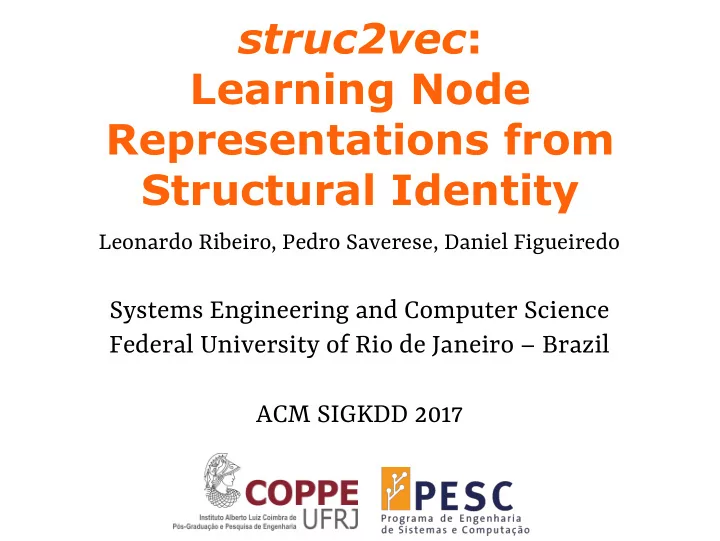

struc2vec : Learning Node Representations from Structural Identity Leonardo Ribeiro, Pedro Saverese, Daniel Figueiredo Systems Engineering and Computer Science Federal University of Rio de Janeiro – Brazil ACM SIGKDD 2017
Node Representations ❑ Map network nodes into Euclidean space ᴏ aka. network embedding preserve distances ❑ Many ways to embed find cliques nodes ❑ Right way depends on application preserve degrees
Structural Identity ❑ Nodes in networks have specific roles ᴏ eg., individuals, web pages, proteins, etc ❑ Structural identity ᴏ identification of nodes based on network structure (no other attribute) ᴏ often related to role played by node ❑ Automorphism: strong structural equivalence ❑ Red, Green: automorphism ❑ Purple, Brown: structurally similar
Related Work ❑ word2vec : framework to embed words (from sentences) into Euclidean space [arXiv’13] ❑ deepwalk : embed network nodes generating sentences through random walks [KDD’14] ❑ node2vec : use biased random walks to generate sentences [KDD’16] Walk on original network to generate context ❑ rolx : use node-feature matrix to compute low rank matrix for roles [KDD’12]
struc2vec ❑ Novel framework for node representations based on structural identity ᴏ structurally similar nodes close in space ❑ Key ideas ❑ Structural similarity does not depend on hop distance ᴏ neighbor nodes can be different, far away nodes can be similar ❑ Structural identity as a hierarchical concept ᴏ depth of similarity varies ❑ Flexible four step procedure ᴏ operational aspect of steps are flexible
Step 1: Structural Similarity ❑ Hierarchical measure for structural similarity between two nodes ❑ R k (u): set of nodes at distance k from u (ring) ❑ s(S): ordered degree sequence of set S v v v u u u s(R 1 (u)) = 1,3,4,4 s(R 2 (u)) = 2,2,2,2 s(R 0 (u)) = 4 s(R 1 (v)) = 4,4,4 s(R 2 (v)) = 1,2,2,2,2 s(R 0 (v)) = 3
Step 1: Structural Similarity ❑ g(D 1 ,D 2 ): distance between two ordered sequences ᴏ cost of pairwise alignment: max(a,b) / min(a,b) -1 ᴏ optimal alignment by DTW in our framework s(R 1 (u)) = 1,3,4,4 s(R 2 (u)) = 2,2,2,2 s(R 0 (u)) = 4 s(R 1 (v)) = 4,4,4 s(R 2 (v)) = 1,2,2,2,2 s(R 0 (v)) = 3 g(. , .) = 3.33 g(. , .) = 1 g(. , .) = 0.33 ❑ f k (u,v): structural distance between nodes u and v considering first k rings ᴏ f k (u,v) = f k-1 (u,v) + g(s(R k (u)), s(R k (v))) f 1 (u,v) = 3.66 f 2 (u,v) = 4.66 f 0 (u,v) = 0.33
Step 2: Multi-layer graph ❑ Encodes structural similarity between all node pairs . . . Layer 0 . . . ❑ Each layer is weighted complete graph . . . Layer 1 ᴏ corresponds to similarity hierarchies ❑ Edge weights in layer k . . . ᴏ w k (u,v) = exp{-f k (u,v)} ❑ Connect corresponding nodes . . . Layer 4 in adjacent layers
Step 3: Generate Context ❑ Context generated by biased random walk ᴏ walking on multi-layer graph ❑ Walk in current layer with probability p ᴏ choose neighbor according to edge weight ᴏ RW prefers more similar nodes ❑ Change layer with probability 1-p ᴏ choose up/down according to edge weight ᴏ RW prefer layer with less similar neighbors
Step 4: Learn Representation ❑ For each node, generate set of . . independent and relative short . random walks . . ᴏ context for node; sentences of a language . . . . . . . . . . ❑ Train a neural network to learn latent representation for nodes ᴏ maximize probability of nodes within . . context . ᴏ Skip-gram (Hierarchical Softmax) adopted
Optimization ❑ Reduce time to generate/store multi-layer graph and context for nodes ❑ OPT1: Reduce length of degree sequences ᴏ use pairs (degree, number of occurrences) ❑ OPT2: Reduce number of edges in multi-layer graph ᴏ only log n neighbors per node ❑ OPT3: Reduce number of layers in multi-layer graph ᴏ fixed (small) number of layers ❑ Scales quasi-linearly ᴏ over 1 million nodes
Barbell Network rolx deepwalk node2vec ❑ Isomorphic nodes very close in space ᴏ similar with OPTs struc2vec
Mirrored Karate Network node2vec struc2vec ❑ Similar roles close in space
Airport Classification ❑ struc2vec helps classification if labels related to role of nodes ❑ Air traffic network: airports, commercial flights ᴏ Brazilian, USA, European (collected from public data) ᴏ airport activity measured in number of flights or movement of people ᴏ four labels according to quartiles of activity ❑ struc2vec (and others) learn node representation from network ᴏ no labels or activity used here
Airport Classification ❑ Node representations used to train classifier ᴏ logistic regression, L2 normalization ❑ struc2vec superior performance ❑ 50% improvement in Brazilian network ❑ Activity related to structure more than neighbors or degree
Conclusion ❑ Structural identity: symmetry concept based on network, related to node roles ❑ struc2vec : flexible framework to learn representations for structural identity ᴏ multi-layer graph encodes structural similarity ❑ struc2vec helps classification based on roles ❑ Yet another useful kind of embedding ᴏ not necessarily a substitute for others Find the right embedding for your task!
Thank You! ❑ Questions and comments? ❑ struc2vec (source code and datasets) https://github.com/leoribeiro/struc2vec
Scalability ❑ G(n,p) network model, avg. deg 10 ᴏ avg running time over 10 networks, OPTs on ❑ Time dominated by computing degree n 1. sequences of rings (yet linear (n) 5 to be optimized)
Distances ❑ Euclidean distance distribution in mirrored Karate network ❑ mirrored pairs much closer than all pairs ❑ not for node2vec
Robustness ❑ Structural similarity under edge removal ᴏ G is a social network ᴏ each edge present in G 1,2 with prob s ❑ Euclidean distance distribution ❑ Corresponding pairs much closer ❑ Even when s is moderate
Recommend
More recommend